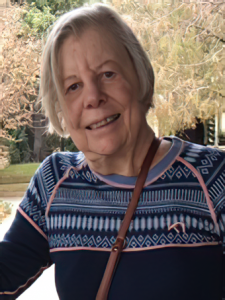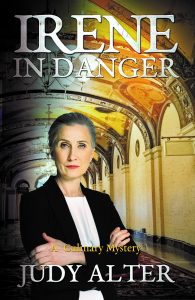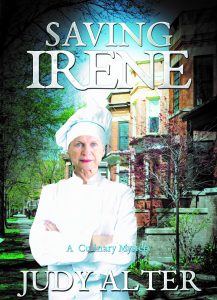Cozy Mysteries, Historical Fiction, and Cookbooks: Judy Alter Does It All!
 One of the joys of featuring guest authors on my blog is that I get to know such interesting people, and Judy Alter certainly qualifies! The author of sixteen delightful cozy mysteries, she’s also a multi-published expert on women of the American West and a cookbook author! Below are her responses to my interview questions followed by her bio and contact/buy links.
One of the joys of featuring guest authors on my blog is that I get to know such interesting people, and Judy Alter certainly qualifies! The author of sixteen delightful cozy mysteries, she’s also a multi-published expert on women of the American West and a cookbook author! Below are her responses to my interview questions followed by her bio and contact/buy links.
First of all, congratulations on the fall release of the second book, Irene in Danger, in your Chicago Culinary Mysteries. Can you tell us about your new release, the series, and what inspired it?
My new series brings together two of my passions—cooking and my Chicago background. I have always been a cook with a few triumphs and more failures, but I find myself increasingly fascinated with writing about food. So that’s probably where the Irene books started. Perhaps it’s a function of aging, but I also find myself increasingly sentimental about my childhood in Chicago’s Hyde Park neighborhood. So I brought the two threads together and had lots of fun researching present-day Chicago. Irene just walked onto the stage, full blown with all her eccentricities. Who knows where she came from?
This is your fourth mystery series. You’ve also written the Kelly O’Connell Mystery series, the Blue Plate Mystery Series, and the Oak Grove Mysteries. Can you share with our readers a bit about the leading characters in each series and what inspired them?
 My leading characters tend to be typical for cozy mysteries—young, usually single (I marry two of them off in their series), with a particular career—real estate, college prof, café owner, etc. And always there’s that element of romance, because I enjoy writing that. My family says Kelly O’Connell is very much autobiographical—a single parent, etc. She’s in real estate because I love looking at houses. In the two Oak Grove mysteries, Susan Hogan’s position teaching English at a university no doubt reflects my thirty years in academia, and Kate Chambers of the Blue Plate is pure fiction—I wrote that series as a sort of tribute to a place and some people that were important to me. The lead character in the Irene books is not the diva chef herself, but her gofer, a young single Texas transplant to Chicago named Henny James.
My leading characters tend to be typical for cozy mysteries—young, usually single (I marry two of them off in their series), with a particular career—real estate, college prof, café owner, etc. And always there’s that element of romance, because I enjoy writing that. My family says Kelly O’Connell is very much autobiographical—a single parent, etc. She’s in real estate because I love looking at houses. In the two Oak Grove mysteries, Susan Hogan’s position teaching English at a university no doubt reflects my thirty years in academia, and Kate Chambers of the Blue Plate is pure fiction—I wrote that series as a sort of tribute to a place and some people that were important to me. The lead character in the Irene books is not the diva chef herself, but her gofer, a young single Texas transplant to Chicago named Henny James.
You’ve spent much of your writing life writing about women of the American West, both fiction and nonfiction, and have won many awards for your work, including induction into the Literary Hall of Fame for Western Writers of America. How did you become so fascinated by this subject area?
When I was in graduate school, my then-husband fancied himself a sculptor, and we often went to what was then the Amon Carter Museum of Western Art in Fort Worth so he could study the work of Remington and Russell. It was free entertainment, and we were poor—he a surgical resident and me a grad student. At the same time my major professor, who is still a good friend today, taught genre literature—westerns, mysteries, sci fi. Those two influences worked on me.
I know that you’ve continued your historical writing, while also writing your mystery series. What led you to take on mystery writing?
 I’m a lifelong mystery fan, starting as so many do with Nancy Drew and Cherry Ames and going on through Murder, She Wrote and right on up to today’s wonderful crop of cozy writers. I always thought if I could publish one mystery, I’d be content. I have published sixteen. I am definitely a low mid-list writer, and my sales would not impress some of our Guppy sisters, but my mysteries get four- and five-star reviews, and I’m content.
I’m a lifelong mystery fan, starting as so many do with Nancy Drew and Cherry Ames and going on through Murder, She Wrote and right on up to today’s wonderful crop of cozy writers. I always thought if I could publish one mystery, I’d be content. I have published sixteen. I am definitely a low mid-list writer, and my sales would not impress some of our Guppy sisters, but my mysteries get four- and five-star reviews, and I’m content.
You’re also a master chef and author of cookbooks! How did you become so interested in cooking?
My mom was a good cook, and she and my dad had frequent dinner parties. Mom let me experiment in the kitchen and encouraged me. By the time I was ten, I was cleaning the kitchen while they entertained. Later in life I was the single parent of four teen-agers and that meant a lot of kitchen time, but I loved it. To give them a sense of family I had big Sunday dinners for fifteen or twenty. I also gave an annual Christmas Tree Trimming party for sixty or seventy of my nearest and dearest and did all the cooking myself. Today I live in a cottage with a tiny kitchen and, due to both zoning and space restrictions, I cook with a hot plate and a toaster oven. But I still feed a family of four many nights.
As someone who writes both nonfiction and fiction, can you talk a little about the differences in your approach and writing process?
One of my sons says I write historical fiction because I’m so poor at plotting, but I think for me that’s the difference. In nonfiction—and historical fiction—the plot is there, laid out. With mysteries you have to create it, and that’s hard. Also I love the research for nonfiction. But nonfiction presents its own challenges in that I am naturally a storyteller, anxious to get beyond documentation and footnotes and tell the interesting story. As a consequence, I describe what I write these days as “creative non-fiction,” a term that causes scholarly historians to shudder.
You’ve also written books for young adults. What have you found are the similarities and differences in writing young adult compared to adult fiction and nonfiction?
My first book was based on the memoir of an older friend, born at the turn of the century. I didn’t know I was writing a juvenile, but that’s how Wm. Morrow and Co. positioned the book—and I was pigeon-holed thereafter for quite a while as a y/a author. I wrote a few more novels but in the Eighties y/a readers weren’t much interested in the American West. A writer friend suggested I break out of that pigeonhole by writing about Elizabeth Bacon Custer, and I did. Many of my young adult books were work-for-hire, written for companies that publish for school libraries. So they involved research and were nonfiction.
In writing for young readers, it’s important to keep their reading level in mind. Once assigned a book for second graders, I had a sharp lesson in short, simple sentences and basic words. On the other hand, you never want to talk down to kids. It’s a delicate balance.
You’ve shared with your readers that you’ve been a writer since childhood. Were you a voracious reader as a young person? What do you think drew you so strongly to writing?
My mother read to me a lot when I was young, and I think that started me on a literary career. But yes, I was a voracious reader—the Bobbsey Twins, the Little Colonel Stories, Terhune’s books about collies, Francis Parkinson Keyes, Nancy Drew. One summer I went to the library every day, came home with a stack of books, read them, and went back the next day for more. I wrote my first story when I was about eleven, submitted to Seventeen in high school, and I think was first published—articles, not books—in my late twenties.
What advice would you give to aspiring writers?
Read a lot, learn the conventions before you experiment, study writing as a business. I made a huge mistake by not considering it a business. I sort of fell into writing because I loved to read, didn’t want to teach, and thought some man would support me while I read and wrote. It didn’t work out that way.
One more lesson that I only learned late in life: network with other authors. Writing is a lonely career, and your family will cheer and applaud but not really grasp the issues you deal with. Joining a writer’s group offers not only support and friendship but practical knowledge on everything from structure of your novel to contracts and the importance of blogs. Sisters in Crime, and more specifically the Guppies sub-group, has been a godsend for me.
Thanks so much for visiting today, Judy!
About Judy Alter
After an award-winning career writing historical fiction about women of the nineteenth-century American West, Judy Alter turned her attention to contemporary cozy mysteries. Several of her Kelly O’Connell Mysteries and Blue Plate Café Mysteries were published by Turquoise Morning Press and are still available. When her publisher went out of business, she became an indie publisher and barely looked back. Find her and a list of her books at http://www.judyalter.com
Judy is an active member of Sisters in Crime, Guppies, Story Circle Network, Women Writing the West, and the Texas Institute of Letters. When she is not writing, she is busy with seven grandchildren and a lively poodle/border collie cross. Her avocation is cooking, and she is the author of Cooking My Way Through Life with Kids and Books, Gourmet on a Hot Plate, and Texas is Chili Country.
Born in Chicago, she has made her home in Fort Worth for over fifty years. Judy is also a proud Scot, a member of Clan MacBean. One trip to the Highlands convinced her that is where her heart is, and she longs to write a novel set in Scotland.
Buy Links
Irene in Danger: Irene in Danger: An Irene in Chicago Culinary Mystery – Kindle edition by Alter, Judy. Mystery, Thriller & Suspense Kindle eBooks @ Amazon.com.
I’m afraid the buy links are “blank”.
Enjoyed learning more about Judy. What a fabulous career! Thank you!
Live Judy’s Irene books! They’re funny and have intriguing plots and characters.
This is great! Congratulations, Judy, on all your books!